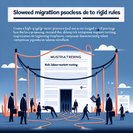
The US Department of Homeland Security has issued an interim final rule ending the 540-day automatic extension of Employment Authorisation Documents (EADs) for H-4 spouses and Adjustment-of-Status applicants, effective 30 October 2025. The change was flagged in law-firm Reddy Neumann Brown’s alert on 29 October and echoed in Crown World Mobility’s weekly update on 30 October.
More than 10,000 Australians hold EAD-dependent status—typically spouses of E-3, H-1B or L-1 professionals. From today, once an EAD expires the holder must stop work until the renewal card is physically issued, a process taking six-to-12 months. Employers therefore face sudden I-9 non-compliance risks and potential project disruption.
Best practice is to lodge renewals at the 180-day mark, upgrade to premium processing where eligible and track expiries in HRIS dashboards. Some companies are exploring intra-US remote-work hiatuses or short-term Canadian assignments for affected spouses.
The rule may face legal challenges, but mobility managers should act now: audit portfolios, brief line managers and update assignment cost projections to include downtime or loss-of-pay contingencies.
The episode highlights growing procedural friction under the second Trump administration and the need for Australian firms to diversify talent hubs.
More than 10,000 Australians hold EAD-dependent status—typically spouses of E-3, H-1B or L-1 professionals. From today, once an EAD expires the holder must stop work until the renewal card is physically issued, a process taking six-to-12 months. Employers therefore face sudden I-9 non-compliance risks and potential project disruption.
Best practice is to lodge renewals at the 180-day mark, upgrade to premium processing where eligible and track expiries in HRIS dashboards. Some companies are exploring intra-US remote-work hiatuses or short-term Canadian assignments for affected spouses.
The rule may face legal challenges, but mobility managers should act now: audit portfolios, brief line managers and update assignment cost projections to include downtime or loss-of-pay contingencies.
The episode highlights growing procedural friction under the second Trump administration and the need for Australian firms to diversify talent hubs.





